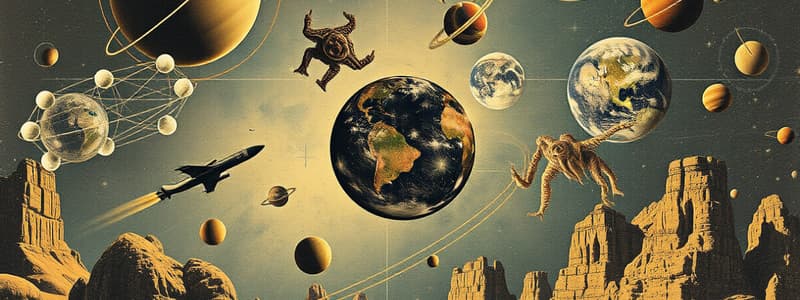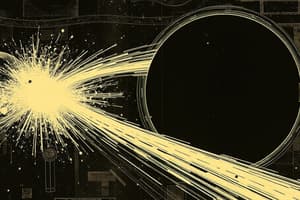Podcast
Questions and Answers
What does astrophysics relate to?
What does astrophysics relate to?
- Mapping celestial bodies
- Study of terrain and rocks on celestial bodies
- Relating physics properties and laws to planets, stars, galaxies, etc. (correct)
- Searching for life on other planets
What is astrometry?
What is astrometry?
Mapping of all celestial bodies
What is astrobiology?
What is astrobiology?
Search for living organisms in/on celestial bodies
What is astrogeology?
What is astrogeology?
What is a theory?
What is a theory?
What is a law?
What is a law?
What is The Big Bang?
What is The Big Bang?
What is matter?
What is matter?
What does Einstein's Theory of Relativity describe?
What does Einstein's Theory of Relativity describe?
Who is Georges Lemaître?
Who is Georges Lemaître?
What is redshift?
What is redshift?
What evidence is cited as proof for the Big Bang?
What evidence is cited as proof for the Big Bang?
What is the Planck Era?
What is the Planck Era?
What happens to the forces of nature as the universe cools down?
What happens to the forces of nature as the universe cools down?
What is gravity?
What is gravity?
What is the strong nuclear force?
What is the strong nuclear force?
What is the weak nuclear force?
What is the weak nuclear force?
What is the electromagnetic force?
What is the electromagnetic force?
What is the creation of elementary particles?
What is the creation of elementary particles?
What are quarks?
What are quarks?
What are leptons?
What are leptons?
What are bosons?
What are bosons?
What is energy imbalance?
What is energy imbalance?
What happens during the interactions of elementary particles?
What happens during the interactions of elementary particles?
What occurs during partner formation?
What occurs during partner formation?
What occurs in the formation of nuclei and atoms?
What occurs in the formation of nuclei and atoms?
What occurs 2 minutes after the Big Bang?
What occurs 2 minutes after the Big Bang?
Flashcards are hidden until you start studying
Study Notes
Astrophysics Terminology
- Astrophysics: Focuses on the physical properties and laws governing celestial bodies like stars and galaxies.
- Astrometry: Involves mapping and measuring the positions of celestial bodies in space.
- Astrobiology: Investigates the potential for life on celestial bodies and the existence of living organisms elsewhere in the universe.
- Astrogeology: Studies the geological characteristics and terrain of celestial bodies.
Scientific Concepts
- Theory: Provides explanations for observed phenomena but does not guarantee truth.
- Law: Describes consistent outcomes in nature based on observational evidence.
Big Bang Theory
- The Big Bang: Refers to the universe's expansion from an extremely hot and dense state not considered an explosion.
- Matter: Originated from a singular point with extreme density and energy, as shown in the equation E=mc², which relates energy, mass, and the speed of light.
Historical Contributions
- Einstein's Theory of Relativity: Contrasts with quantum mechanics and addresses the behavior of matter at a cosmic scale.
- Georges Lemaître: Proposed the Big Bang Theory, observing the reduction in density and temperature along with redshift phenomena.
Redshift Phenomenon
- Redshift: Occurs when the frequency of light from distant stars decreases, indicating that the universe is enlarging.
- Cosmic Microwave Background (CMB): Radiative evidence supporting the Big Bang, showcasing early universe conditions as it cooled.
Stages of the Universe
- Planck Era: Initial stage post-Big Bang characterized by exceedingly high temperature and energy, unsuitable for common matter.
- Forces of Nature: Unified force separated into distinctive forces (gravity, strong nuclear, weak nuclear, and electromagnetic) as the universe cooled.
Elementary Particle Formation
- Creation of Elementary Particles: Transition from pure energy to matter as temperature decreased. Building blocks include quarks, leptons, and bosons.
- Quarks: Possess fractional charges and combine in varying odd/even configurations.
- Leptons: Include neutrinos, and the electron with a charge of -1.
- Bosons: Act as force carriers; includes gluons (strong force) and photons (electromagnetic radiation traveling at light speed).
Energy Dynamics
- Energy Imbalance: Majority of energy turned into matter-antimatter pairs, leading to annihilation, while a matter surplus allowed for stability in matter formation.
###Interactions and Structures
- Interactions of Elementary Particles: Quarks densely packed facilitating strong interactions, leading to asymmetries.
- Partner Formation: As conditions cooled, quarks merged into hadrons, maintaining matter-antimatter imbalance.
Nuclei and Atom Formation
- Formation of Nuclei and Atoms: Universe expanding with significant diameter, resulting in protons and neutrons pairing to form hydrogen (90%) and helium (10%) nuclei.
- Formation Process: Half the temperature of the Sun allowed free electrons to combine with nuclei, generating visible light as they lost energy.
Studying That Suits You
Use AI to generate personalized quizzes and flashcards to suit your learning preferences.





